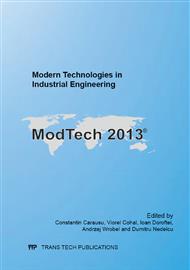p.651
p.657
p.663
p.669
p.675
p.682
p.688
p.694
p.699
Orthopaedic Prosthetic Systems Topographically Characterized at Nanometric Scale
Abstract:
The main purpose of this project was to study and improve the tribological characteristics of hip and knee prostheses in order to use them for a longer period of time. We conducted a thorough investigation of components of hip and knee prostheses. We started with the study of hip prostheses obtained after revision surgery. In this paper we present some experimental results about the scratch resistance of Ti6Al4V alloy and Co-Cr alloy femoral heads coated by physical vapor deposition (PVD) with TiN and Co-Cr-Mo, respectively. Visual analysis and optical microscopy analysis of prosthetic components revealed numerous multi-directional scratches, deeper or less deep, frosted the surface in the geometric place of action of the resultant force application point, microcorossion and peeling of the coating on the prosthetic femoral heads made of CoCr coated with CoCrMo by PVD method. Scratches, corrosion, peeling and bio-tribo-corrosion of titanium nitride (TiN) coating from the Ti6Al4V femoral heads surface were also observed. Using atomic force microscopy (AFM), topographic characterization at nanometric scale of these surfaces was realized. Surface topography parameters such as minimum and maximum height, average roughness, and surface asymmetry were derived. It resulted that under the deposition there is a more veiled area. Roughness was used as an indicator of damage to the femoral head to obtain information on the variation in height from one point to another. AFM analysis revealed a dramatic increase in average roughness (Ra) of femoral heads compared to the maximum value of 0.05 μm provided under ISO 7206-2. From all these studies it was noted the need for a resistant prostheses, with anticorrosive composition and high mechanical properties. Among the numerous methods to reduce wear we realized thin films (biocompatible nanomaterials) deposition of TiN on 316L SS steel substrates by pulsed laser deposition method (PLD), to improve overall performance and, in particular, mechanical prosthesis of hip prostheses structures. The results obtained leads to the conclusion that PLD technique is a good method to make amorphous and crystalline films, dense and porous by controlling the laser system conditions. All parameters can be controlled and varied to identify the optimum structures and to obtain thin layers.
Info:
Periodical:
Pages:
675-681
Citation:
Online since:
November 2013
Authors:
Price:
Сopyright:
© 2014 Trans Tech Publications Ltd. All Rights Reserved
Share:
Citation:


